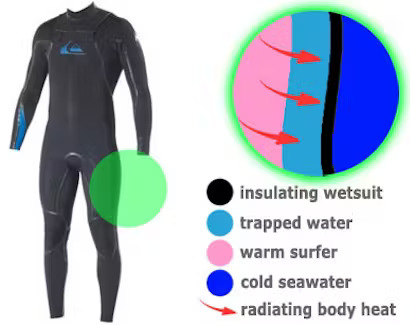Scuba Wetsuits vs. Surfing Wetsuits
Posted by Barbara Alvarado on on Oct 21st 2023
Wetsuits play a vital role in enhancing comfort and safety for water enthusiasts. While scuba diving and surfing are both thrilling water activities, they require different types of wetsuits. In this blog, we will dive into the key differences between scuba wetsuits and surfing wetsuits, shedding light on their unique features and functionalities.

Thickness and Insulation:
One of the primary distinctions between scuba wetsuits and surfing wetsuits lies in their thickness and insulation. Scuba wetsuits are typically thicker to provide better insulation against cold water temperatures. This extra insulation helps divers stay warm during prolonged periods underwater. In contrast, surfing wetsuits are generally thinner to allow for greater mobility and flexibility in the water, as surfers require a wide range of movement for paddling and riding waves.

Material and Design:
Scuba wetsuits are often made from neoprene, a synthetic rubber that offers excellent insulation properties. These wetsuits are designed to withstand the high pressures experienced at greater depths. They often feature reinforced knees and elbows for added durability and protection. Surfing wetsuits, on the other hand, are crafted with a focus on flexibility and ease of movement. They are typically made from a combination of neoprene and stretchier materials to allow surfers to paddle and maneuver more efficiently in the water.
Zipper Placement:
Another notable difference is the placement of zippers. Scuba wetsuits commonly feature back zippers, which are easier to reach and operate with the help of a diving buddy. This design allows divers to don and doff their wetsuits more conveniently. Surfing wetsuits, however, often have front or chest zippers. These zippers provide a better seal against water entry and minimize flushing when surfers are paddling or being submerged by waves.
Additional Features:
Scuba wetsuits often incorporate additional features to enhance safety and functionality underwater. These may include reinforced knee pads, integrated hoods, and wrist and ankle seals to prevent water ingress. Surfing wetsuits, on the other hand, prioritize features such as seamless paddle zones, extra stretch panels, and strategic seam placement to optimize flexibility and performance in the waves.

While both scuba wetsuits and surfing wetsuits serve the purpose of keeping water enthusiasts comfortable and protected, they cater to different needs and environments. Scuba wetsuits prioritize insulation and durability for prolonged exposure to cold waters at depth, while surfing wetsuits emphasize mobility and flexibility for dynamic movements on the waves. Understanding these differences will help water enthusiasts choose the right wetsuit for their preferred aquatic activity, ensuring an enjoyable and safe experience.

